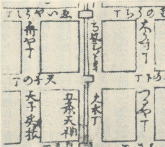Tekura lived with her family in a part of Kyoto known
as gDaiusu-cho,h located in the Ichijo-Aburakoji and
Horikawa Street area. The name gDaiusuh is derived
from gDeush and was the area of Kyoto in which Christians lived. It was
given this name because one of Kyotofs magistrates, Keiyu, of the Maeda
Gen-i family, a devout Christian lived there. For no other reason than
that he was a Christian, Keiyu was stripped of the property and status
and thereafter he and his family lived in Daiusu-cho. Gradually, Christian
samurai and artisans gathered round about to form a town.
In 1619, 22 years after the death of the 26 Martyrs, the Shogun Hidetada issued a severe edict banning Christianity. At the time, Kyoto shoshidai, Itakura Katsushige bore no ill will towards Christians and had been in
the habit of ignoring accusations against them. However, his son, Shigemune,
arrived with news about the Shogunfs edict and pointed out that the Shogunfs
anger would fall upon their own family if they ignored it further.
Katsushige therefore took to persecute Christians.
The inhabitants of Daiusu-cho were his first targets. Government officials
surrounded the town gates, broke down doors, pushed into houses and arrested
all the members of families who had pictures of saints on their walls In
houses without pictures of saints, the Government officials would ask whether
or not the people living there were Christians. Anyone who confessed to
be a Christian was arrested.
Since the residents of gDaiusu townh were wealthy, and of superior social
status, and there were also talented artisans among them, they owned many
swords, and had expensive fixtures and exquisite tea utensils in their
houses.
Government officials broke into any unoccupied houses when Christians were
arrested and took whatever they wanted. Many Christians including
small children, regardless of age or sex, were arrested, Tekura and her
family among them.
@@ @@@@@@ @@(Esther Atsuji is responsible for the wording of
this article.)
@@@@@@@@
<Large Martyrdom of Kyoto, Daiusu town>
A map of Kyoto in olden times, showing Daiusu-cho
Footprints of Tekura Hashimoto@No.2
References
ú{LV^}³j@Ъígij
sÌå}³ÖW¿³aTNisLV^¤ïÒ§j
úV·PXWTNRPUú@`ߢÌST`

